RENAULT MASTER 2018 Service Manual
Manufacturer: RENAULT, Model Year: 2018, Model line: MASTER, Model: RENAULT MASTER 2018Pages: 290, PDF Size: 7.1 MB
Page 41 of 290
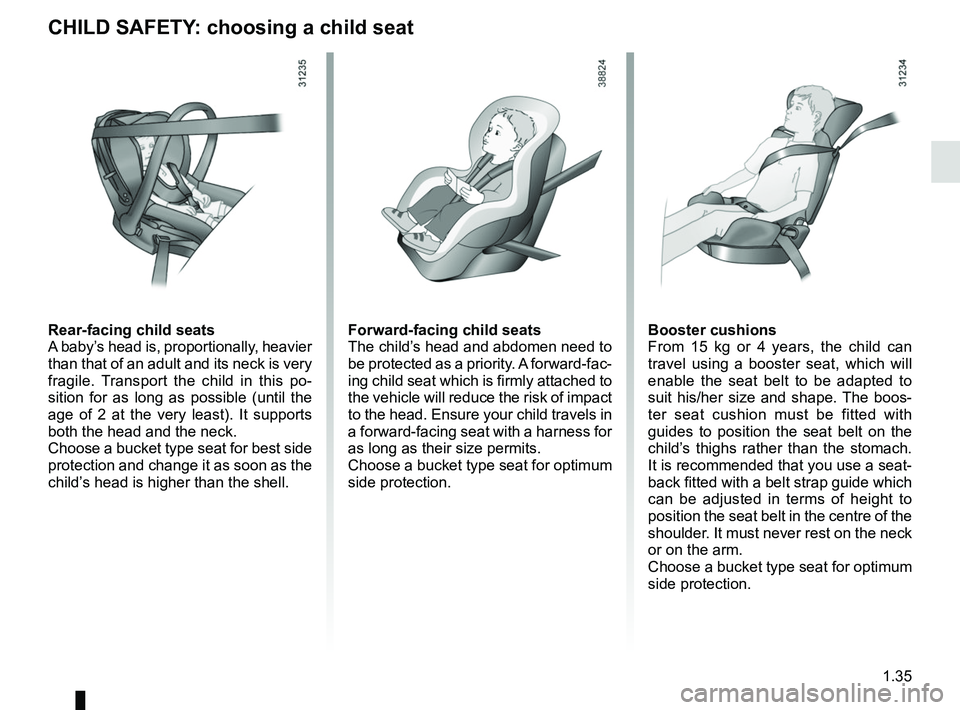
1.35
CHILD SAFETY: choosing a child seat
Rear-facing child seats
A baby’s head is, proportionally, heavier
than that of an adult and its neck is very
fragile. Transport the child in this po-
sition for as long as possible (until the
age of 2 at the very least). It supports
both the head and the neck.
Choose a bucket type seat for best side
protection and change it as soon as the
child’s head is higher than the shell.Forward-facing child seats
The child’s head and abdomen need to
be protected as a priority. A forward-fac-
ing child seat which is firmly attached to
the vehicle will reduce the risk of impact
to the head. Ensure your child travels in
a forward-facing seat with a harness for
as long as their size permits.
Choose a bucket type seat for optimum
side protection.Booster cushions
From 15 kg or 4 years, the child can
travel using a booster seat, which will
enable the seat belt to be adapted to
suit his/her size and shape. The boos-
ter seat cushion must be fitted with
guides to position the seat belt on the
child’s thighs rather than the stomach.
It is recommended that you use a seat-
back fitted with a belt strap guide which
can be adjusted in terms of height to
position the seat belt in the centre of the
shoulder. It must never rest on the neck
or on the arm.
Choose a bucket type seat for optimum
side protection.
Page 42 of 290
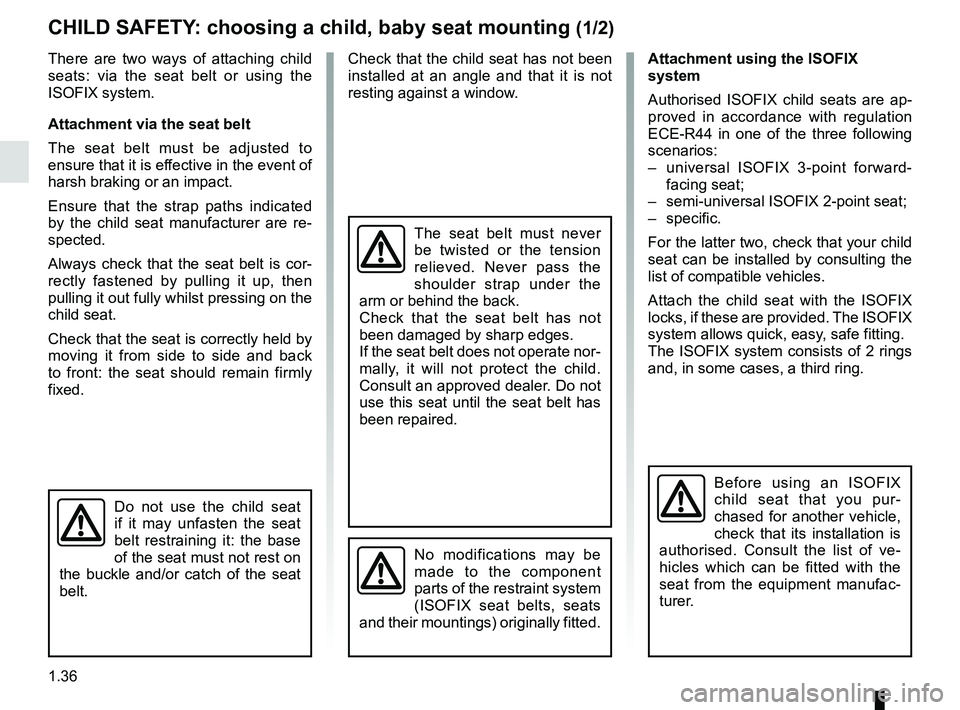
1.36
CHILD SAFETY: choosing a child, baby seat mounting (1/2)
There are two ways of attaching child
seats: via the seat belt or using the
ISOFIX system.
Attachment via the seat belt
The seat belt must be adjusted to
ensure that it is effective in the event of
harsh braking or an impact.
Ensure that the strap paths indicated
by the child seat manufacturer are re-
spected.
Always check that the seat belt is cor-
rectly fastened by pulling it up, then
pulling it out fully whilst pressing on the
child seat.
Check that the seat is correctly held by
moving it from side to side and back
to front: the seat should remain firmly
fixed.Attachment using the ISOFIX
system
Authorised ISOFIX child seats are ap-
proved in accordance with regulation
ECE-R44 in one of the three following
scenarios:
– universal ISOFIX 3-point forward-
facing seat;
– semi-universal ISOFIX 2-point seat;
– specific.
For the latter two, check that your child
seat can be installed by consulting the
list of compatible vehicles.
Attach the child seat with the ISOFIX
locks, if these are provided. The ISOFIX
system allows quick, easy, safe fitting.
The ISOFIX system consists of 2 rings
and, in some cases, a third ring.
Before using an ISOFIX
child seat that you pur-
chased for another vehicle,
check that its installation is
authorised. Consult the list of ve-
hicles which can be fitted with the
seat from the equipment manufac-
turer.
No modifications may be
made to the component
parts of the restraint system
(ISOFIX seat belts, seats
and their mountings) originally fitted.
The seat belt must never
be twisted or the tension
relieved. Never pass the
shoulder strap under the
arm or behind the back.
Check that the seat belt has not
been damaged by sharp edges.
If the seat belt does not operate nor-
mally, it will not protect the child.
Consult an approved dealer. Do not
use this seat until the seat belt has
been repaired.
Do not use the child seat
if it may unfasten the seat
belt restraining it: the base
of the seat must not rest on
the buckle and/or catch of the seat
belt.
Check that the child seat has not been
installed at an angle and that it is not
resting against a window.
Page 43 of 290
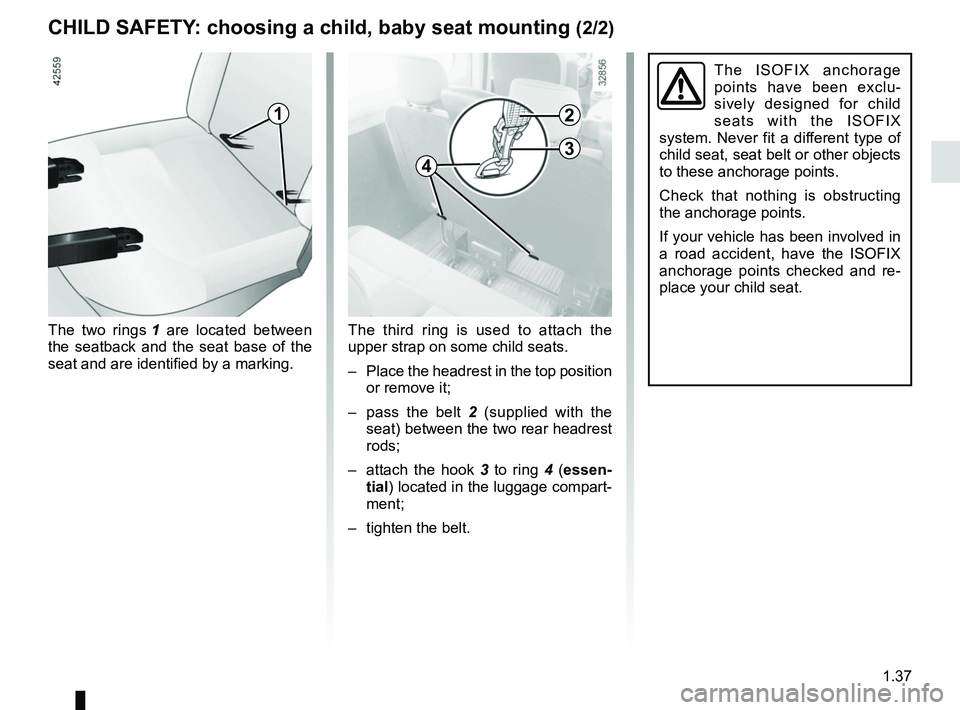
1.37
CHILD SAFETY: choosing a child, baby seat mounting (2/2)
The ISOFIX anchorage
points have been exclu-
sively designed for child
seats with the ISOFIX
system. Never fit a different type of
child seat, seat belt or other objects
to these anchorage points.
Check that nothing is obstructing
the anchorage points.
If your vehicle has been involved in
a road accident, have the ISOFIX
anchorage points checked and re-
place your child seat.
The third ring is used to attach the
upper strap on some child seats.
– Place the headrest in the top position or remove it;
– pass the belt 2 (supplied with the
seat) between the two rear headrest
rods;
– attach the hook 3 to ring 4 (essen-
tial) located in the luggage compart-
ment;
– tighten the belt.
The two rings
1 are located between
the seatback and the seat base of the
seat and are identified by a marking.
12
3
4
Page 44 of 290
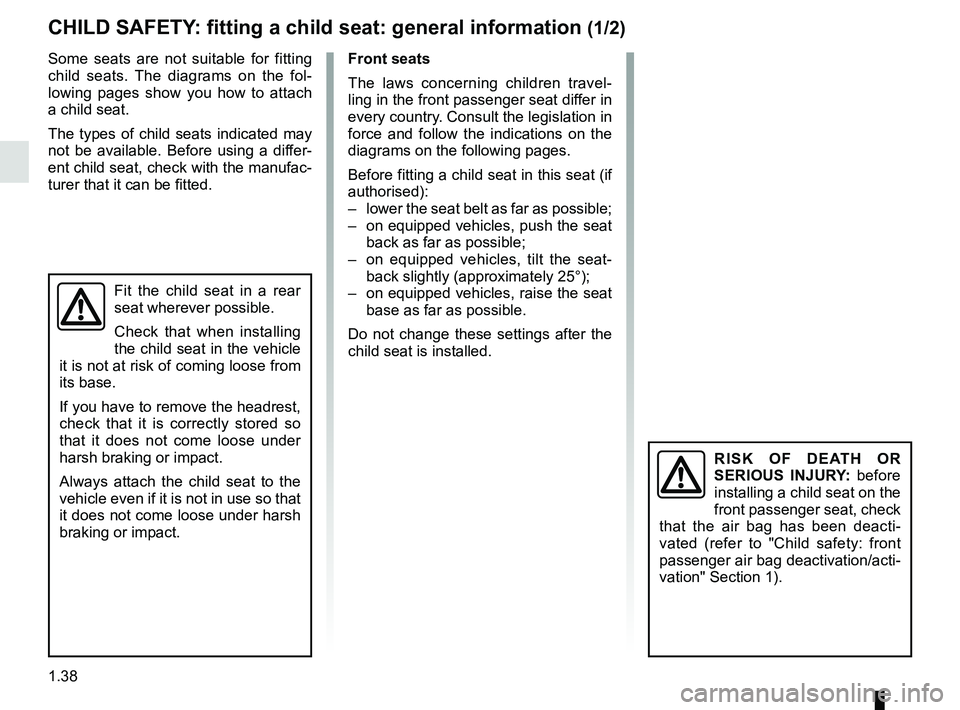
1.38
CHILD SAFETY: fitting a child seat: general information (1/2)
Some seats are not suitable for fitting
child seats. The diagrams on the fol-
lowing pages show you how to attach
a child seat.
The types of child seats indicated may
not be available. Before using a differ-
ent child seat, check with the manufac-
turer that it can be fitted.
Fit the child seat in a rear
seat wherever possible.
Check that when installing
the child seat in the vehicle
it is not at risk of coming loose from
its base.
If you have to remove the headrest,
check that it is correctly stored so
that it does not come loose under
harsh braking or impact.
Always attach the child seat to the
vehicle even if it is not in use so that
it does not come loose under harsh
braking or impact.
Front seats
The laws concerning children travel-
ling in the front passenger seat differ in
every country. Consult the legislation in
force and follow the indications on the
diagrams on the following pages.
Before fitting a child seat in this seat (if
authorised):
– lower the seat belt as far as possible;
– on equipped vehicles, push the seat back as far as possible;
– on equipped vehicles, tilt the seat- back slightly (approximately 25°);
– on equipped vehicles, raise the seat base as far as possible.
Do not change these settings after the
child seat is installed.
RISK OF DEATH OR
SERIOUS INJURY: before
installing a child seat on the
front passenger seat, check
that the air bag has been deacti-
vated (refer to "Child safety: front
passenger air bag deactivation/acti-
vation" Section 1).
Page 45 of 290
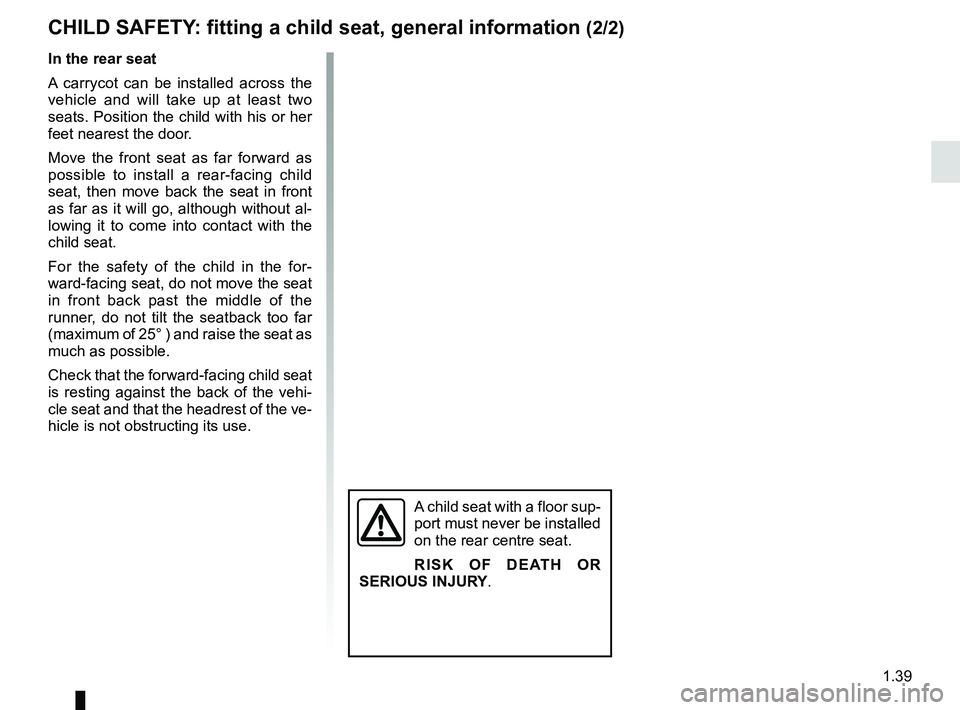
1.39
CHILD SAFETY: fitting a child seat, general information (2/2)
A child seat with a floor sup-
port must never be installed
on the rear centre seat.
RISK OF DEATH OR
SERIOUS INJURY.
In the rear seat
A carrycot can be installed across the
vehicle and will take up at least two
seats. Position the child with his or her
feet nearest the door.
Move the front seat as far forward as
possible to install a rear-facing child
seat, then move back the seat in front
as far as it will go, although without al-
lowing it to come into contact with the
child seat.
For the safety of the child in the for-
ward-facing seat, do not move the seat
in front back past the middle of the
runner, do not tilt the seatback too far
(maximum of 25° ) and raise the seat as
much as possible.
Check that the forward-facing child seat
is resting against the back of the vehi-
cle seat and that the headrest of the ve-
hicle is not obstructing its use.
Page 46 of 290
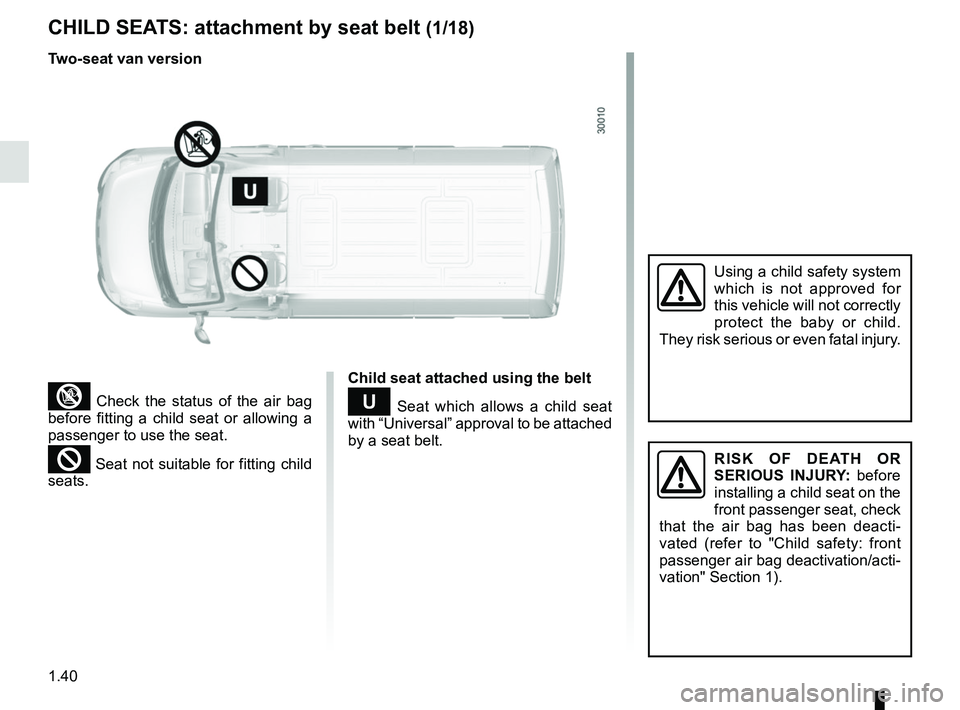
1.40
CHILD SEATS: attachment by seat belt (1/18)
³ Check the status of the air bag
before fitting a child seat or allowing a
passenger to use the seat.
² Seat not suitable for fitting child
seats.
Using a child safety system
which is not approved for
this vehicle will not correctly
protect the baby or child.
They risk serious or even fatal injury.
Two-seat van version
RISK OF DEATH OR
SERIOUS INJURY: before
installing a child seat on the
front passenger seat, check
that the air bag has been deacti-
vated (refer to "Child safety: front
passenger air bag deactivation/acti-
vation" Section 1).
Child seat attached using the belt
¬ Seat which allows a child seat
with “Universal” approval to be attached
by a seat belt.
Page 47 of 290
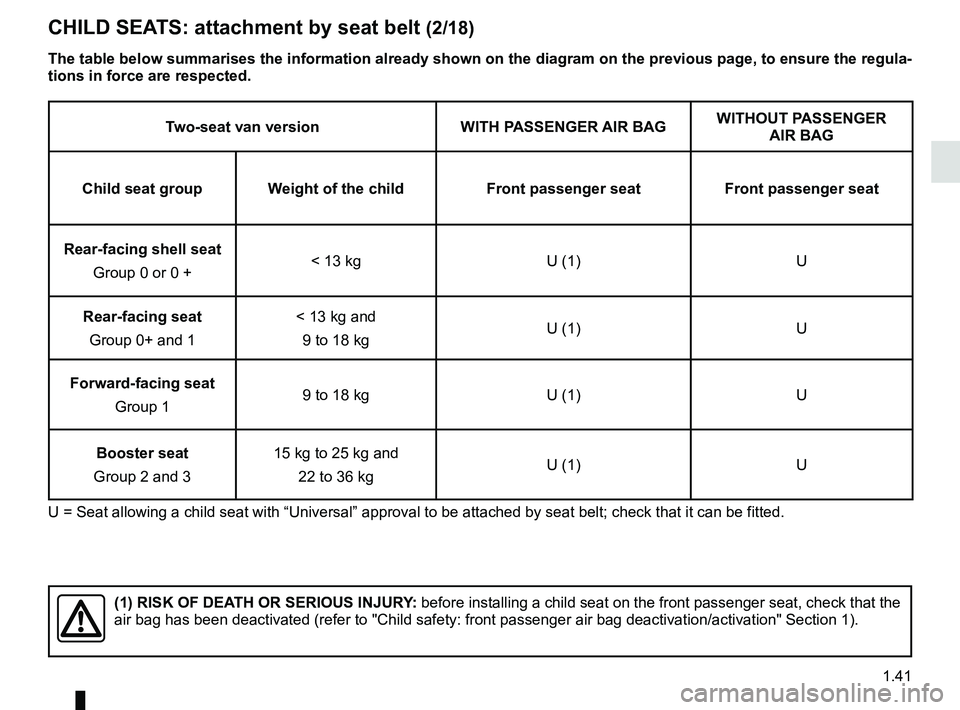
1.41
CHILD SEATS: attachment by seat belt (2/18)
Two-seat van versionWITH PASSENGER AIR BAGWITHOUT PASSENGER
AIR BAG
Child seat group Weight of the child Front passenger seatFront passenger seat
Rear-facing shell seat Group 0 or 0 + < 13 kg
U (1) U
Rear-facing seat Group 0+ and 1 < 13 kg and
9 to 18 kg U (1)
U
Forward-facing seat Group 1 9 to 18 kg
U (1) U
Booster seat
Group 2 and 3 15 kg to 25 kg and
22 to 36 kg U (1)
U
U = Seat allowing a child seat with “Universal” approval to be attache\
d by seat belt; check that it can be fitted.
(1) RISK OF DEATH OR SERIOUS INJURY: before installing a child seat on the front passenger seat, check that \
the
air bag has been deactivated (refer to "Child safety: front passenger a\
ir bag deactivation/activation" Section 1).
The table below summarises the information already shown on the diagram \
on the previous page, to ensure the regula-
tions in force are respected.
Page 48 of 290
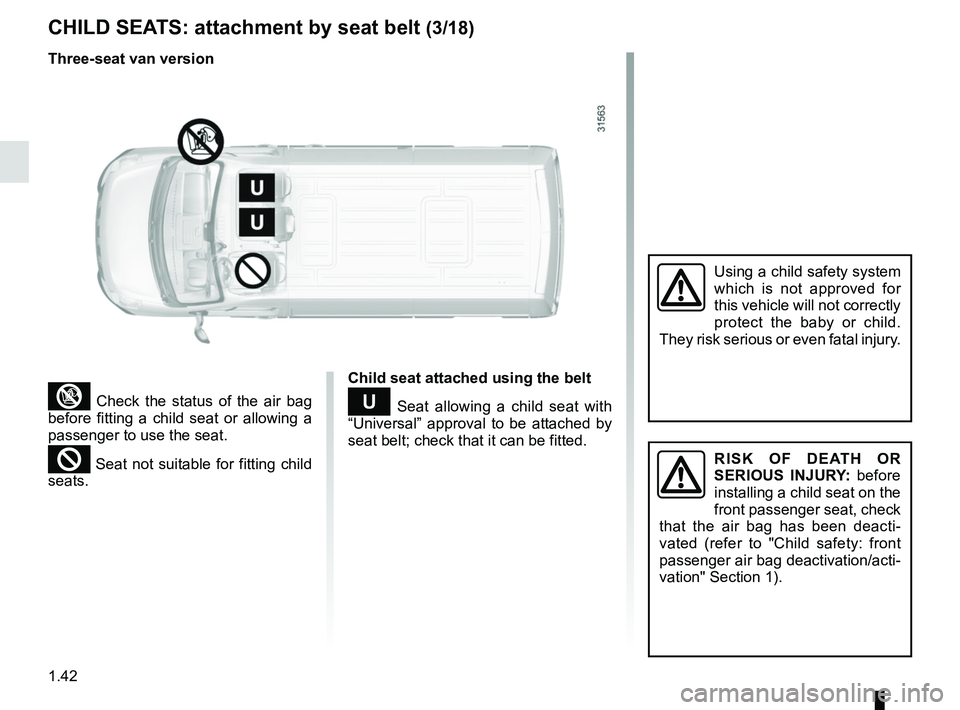
1.42
CHILD SEATS: attachment by seat belt (3/18)
³ Check the status of the air bag
before fitting a child seat or allowing a
passenger to use the seat.
² Seat not suitable for fitting child
seats.
Using a child safety system
which is not approved for
this vehicle will not correctly
protect the baby or child.
They risk serious or even fatal injury.
Three-seat van version
RISK OF DEATH OR
SERIOUS INJURY: before
installing a child seat on the
front passenger seat, check
that the air bag has been deacti-
vated (refer to "Child safety: front
passenger air bag deactivation/acti-
vation" Section 1).
Child seat attached using the belt
¬ Seat allowing a child seat with
“Universal” approval to be attached by
seat belt; check that it can be fitted.
Page 49 of 290
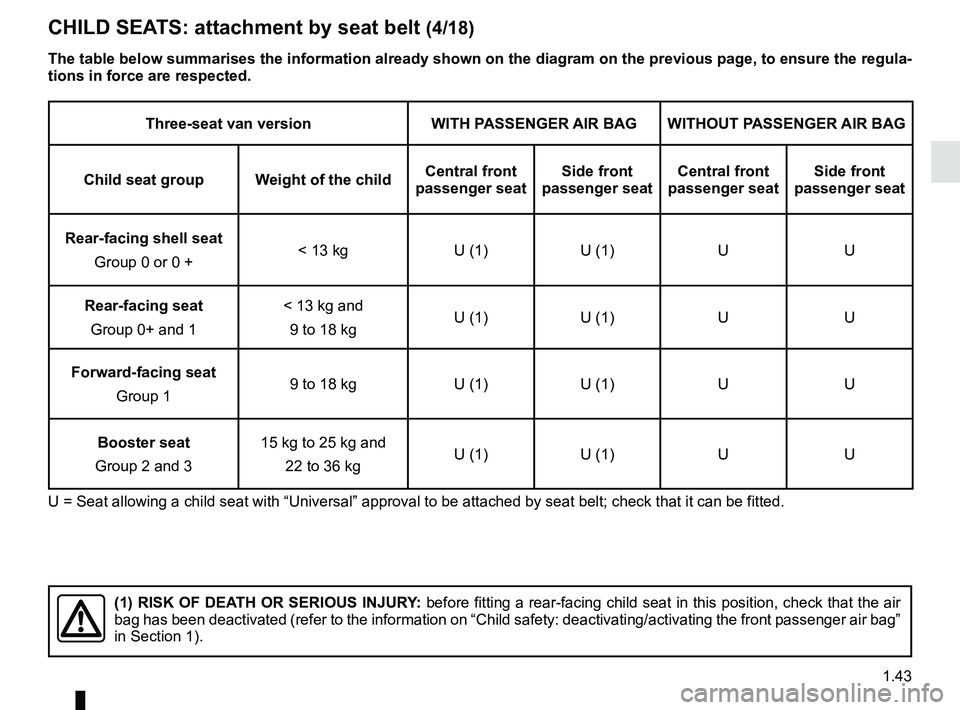
1.43
CHILD SEATS: attachment by seat belt (4/18)
Three-seat van versionWITH PASSENGER AIR BAG WITHOUT PASSENGER AIR BAG
Child seat group Weight of the child Central front
passenger seat Side front
passenger seat Central front
passenger seat Side front
passenger seat
Rear-facing shell seat Group 0 or 0 + < 13 kg
U (1)U (1) UU
Rear-facing seat Group 0+ and 1 < 13 kg and
9 to 18 kg U (1)
U (1) UU
Forward-facing seat Group 1 9 to 18 kg
U (1)U (1) UU
Booster seat
Group 2 and 3 15 kg to 25 kg and
22 to 36 kg U (1)
U (1) UU
U = Seat allowing a child seat with “Universal” approval to be attache\
d by seat belt; check that it can be fitted.
(1) RISK OF DEATH OR SERIOUS INJURY: before fitting a rear-facing child seat in this position, check that th\
e air
bag has been deactivated (refer to the information on “Child safety:\
deactivating/activating the front passenger air bag”
in Section 1).
The table below summarises the information already shown on the diagram \
on the previous page, to ensure the regula-
tions in force are respected.
Page 50 of 290
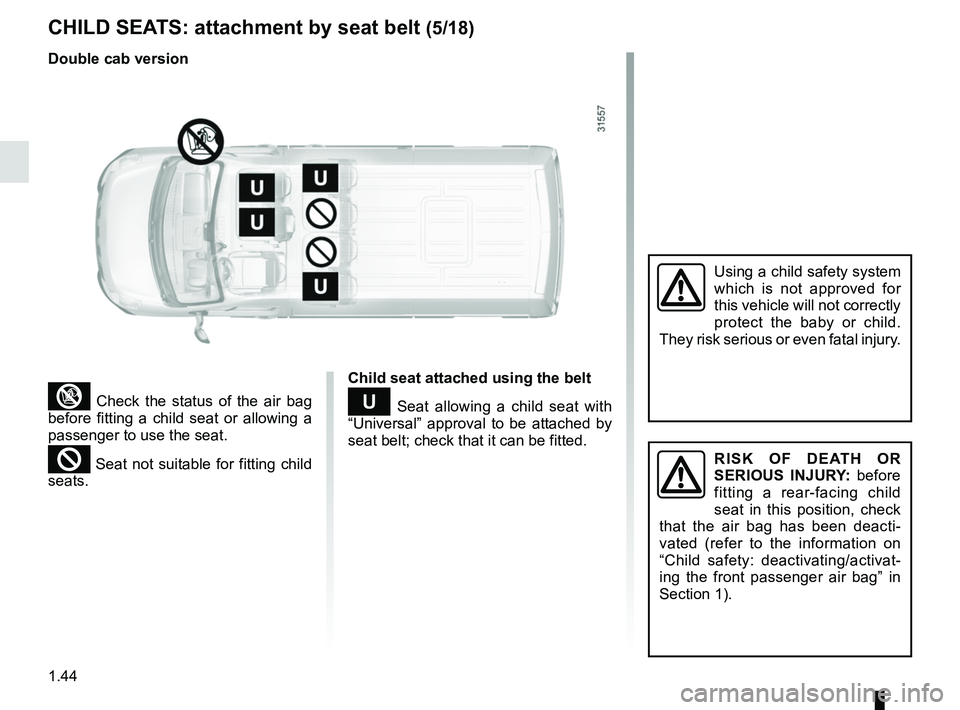
1.44
CHILD SEATS: attachment by seat belt (5/18)
³ Check the status of the air bag
before fitting a child seat or allowing a
passenger to use the seat.
² Seat not suitable for fitting child
seats.
Using a child safety system
which is not approved for
this vehicle will not correctly
protect the baby or child.
They risk serious or even fatal injury.
RISK OF DEATH OR
SERIOUS INJURY: before
fitting a rear-facing child
seat in this position, check
that the air bag has been deacti-
vated (refer to the information on
“Child safety: deactivating/activat-
ing the front passenger air bag” in
Section 1).
Double cab version
Child seat attached using the belt
¬ Seat allowing a child seat with
“Universal” approval to be attached by
seat belt; check that it can be fitted.